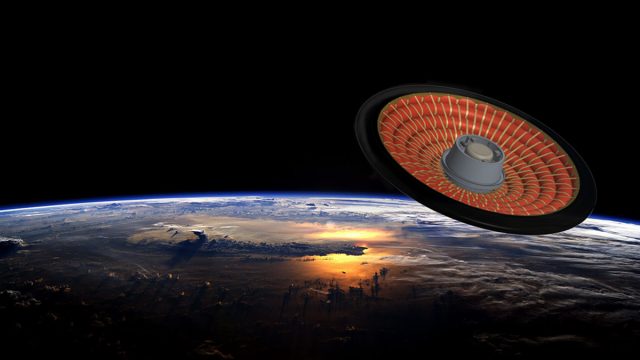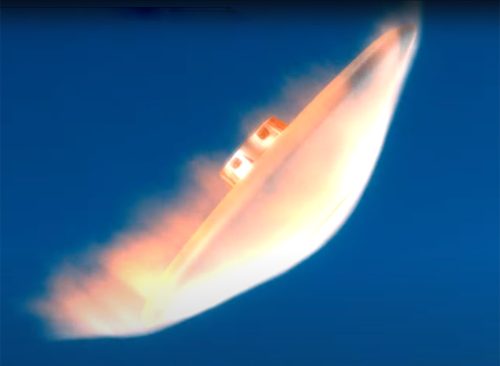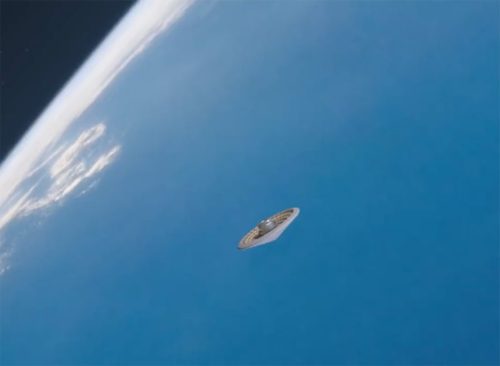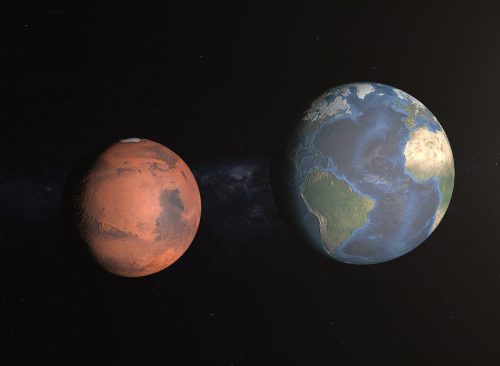NASA is Launching a Massive Inflatable Heat Shield That Looks Like Flying Saucer Into Space
It could support landing crew on Mars.

A major goal of the US space program is to land a manned mission on Mars within the next decade. One problem: The red planet’s atmosphere is so thin that any spacecraft heavy enough to hold humans wouldn’t be able to slow down enough to land safely. But this week, NASA is testing a potential solution. It’s a giant heat shield that would act like a brake to slow down a Mars-bound spacecraft. (And it looks like a giant flying saucer.)
The Low-Earth Orbit Flight Test of an Inflatable Decelerator (LOFTID) was scheduled to launch on an Atlas V rocket on Wednesday from Vandenberg Space Force Base in California. “This technology could support landing crew and large robotic missions on Mars, as well as returning heavier payloads to Earth,” NASA says. Read on to find out how it would work, and what this week’s test will involve.

The plan is for LOFTID, a 20-foot-wide heat shield, to be launched on a rocket that’s also carrying a polar-orbiting weather satellite. After the satellite is delivered, LOFTID will be deployed in Earth’s upper atmosphere, where it will inflate, then descend back to Earth.
If all goes well, LOFTID will decelerate from hypersonic flight—more than 25 times faster than the speed of sound—to subsonic flight, less than 609 miles per hour. A parachute will allow the craft to splash down in the Pacific Ocean.
During the flight, some data will be transmitted to NASA while sensors and cameras record more information on a “black box” that will be retrieved from the water.

As a spacecraft enters an atmosphere, aerodynamic drag helps slow it down. But the atmosphere on Mars is much thinner than on Earth. “The atmosphere is thick enough to provide some drag, but too thin to decelerate the spacecraft as quickly as it would in Earth’s atmosphere,” said NASA. A simple parachute, like the one employed by NASA’s unmanned Perseverance rover that landed on Mars last year, would be too weak to slow down a heavy manned craft.
Ultimately, experts hope it would help a spacecraft to decelerate while protecting it from heat, two major requirements for a manned Mars landing. “This technology could support landing crew and large robotic missions on Mars, as well as returning heavier payloads to Earth,” said NASA.

In June, NASA inflated a test version of LOFTID on Earth and published video of the test, along with animations of what it would look like when deployed above other planets. In late September, the agency published a longer 90-second animation that shows, step-by-step, how LOFTID is intended to work during its test in low Earth orbit, from launch, to re-entry into the Earth’s atmosphere, to splashdown.
LOFTID, @NASA‘s Low Earth Orbit Test of an Inflatable Decelerator, was inflated for the last time on Earth this week. Its next stop? Space!
Learn more about how LOFTID could take us to Mars here: https://t.co/3dWVkSoi3j pic.twitter.com/XoPgIf5Y8Q
— NASA Langley Research Center (@NASA_Langley) June 15, 2022

In February 2021, NASA landed the unmanned Perseverance rover on Mars. “The mission addresses high-priority science goals for Mars exploration, including key questions about the potential for life on Mars,” the agency says. It’s testing for previous signs of life on the planet—which is essentially a vast desert—and how human life might be supported there in the future. “The mission also provides opportunities to gather knowledge and demonstrate technologies that address the challenges of future human expeditions to Mars,” says the agency.
“These include testing a method for producing oxygen from the Martian atmosphere, identifying other resources (such as subsurface water), improving landing techniques, and characterizing weather, dust, and other potential environmental conditions that could affect future astronauts living and working on Mars.”
RELATED: The 10 Most “OMG” Science Discoveries of 2022

In September, NASA released its objectives for the Moon to Mars initiative, in which it detailed plans to further explore the moon and the red planet. The agency said it plans to send the first humans back to orbit the Moon “no earlier than” 2024 on the Artemis II craft, and to the lunar surface “no earlier than” 2025 on Artemis III. NASA hasn’t set a date for a potential Mars mission but siad it will use findings from the Artemis missions to test “systems and concepts” for a Mars expedition.
“We wanted to shape objectives to guide the upcoming missions, as opposed to previous approaches, which consisted of building elements and capabilities first to support the campaign,” said Kurt Vogel, director of space architectures in the office of the NASA Administrator.














